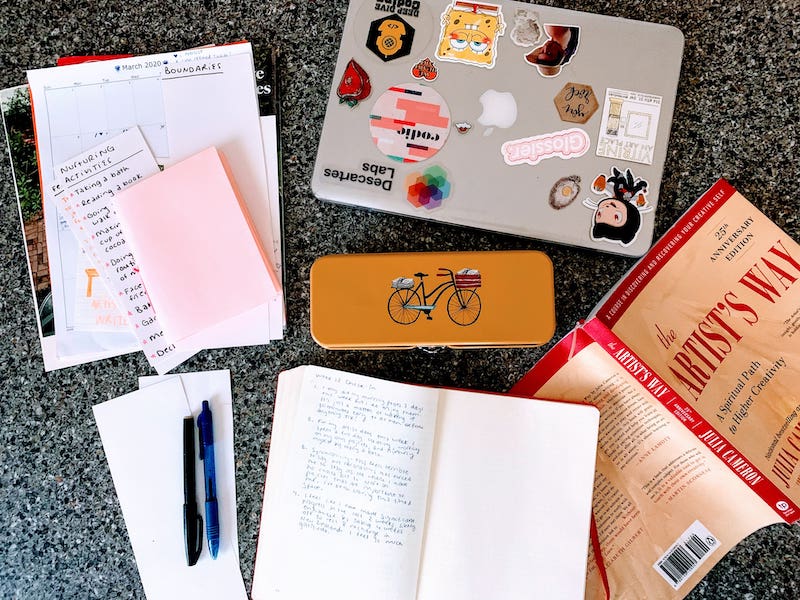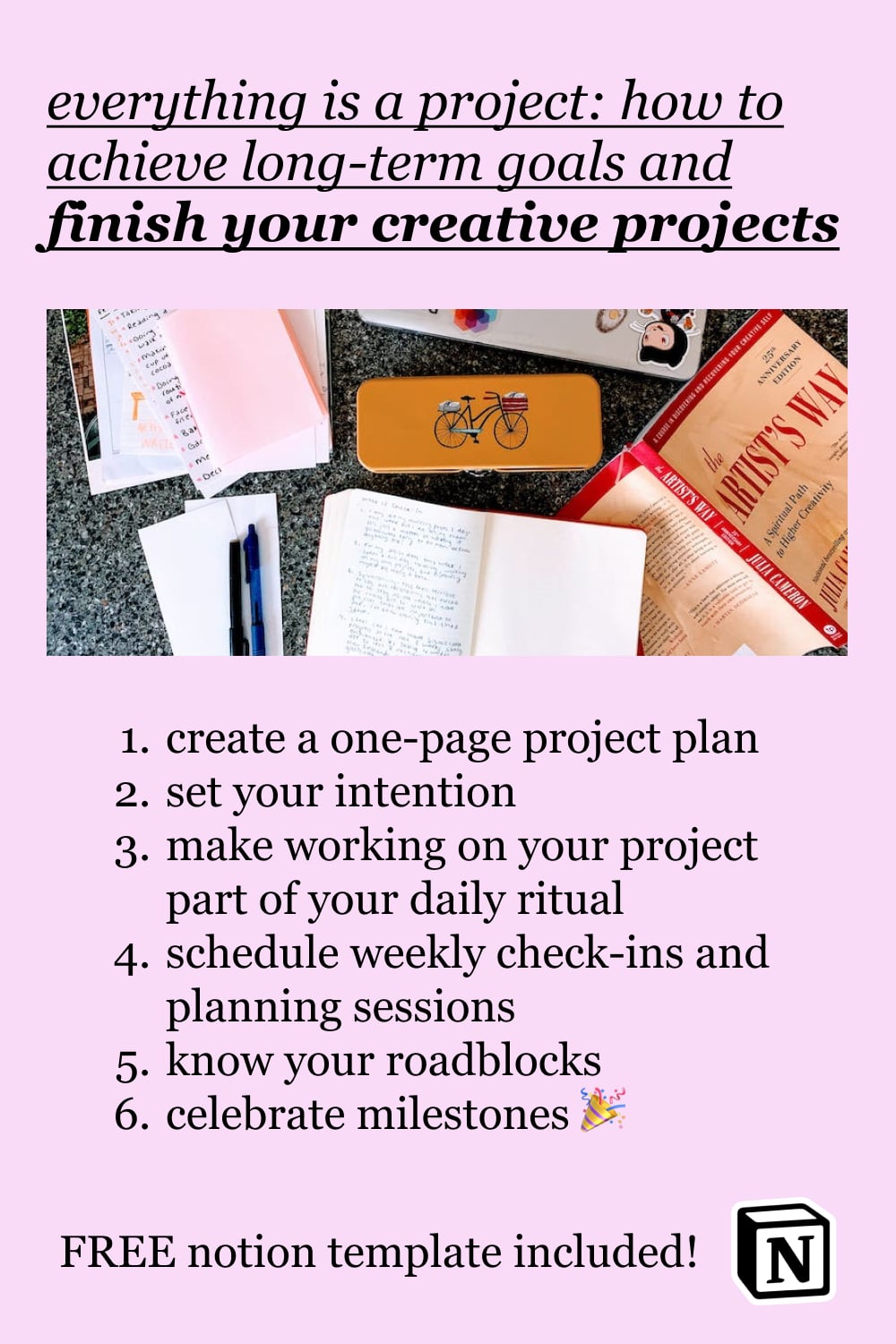Everything is a project: How to achieve long-term goals and finish your creative projects
One of my favorite people on Twitter, @visakanv, posted a great thread about project management back in 2019.
if you are 2-3% better at project management, over time this compounds to gains in \\*everything else\\*, because everything worth doing is a project to be managed
— visa is chilling tf out (@visakanv) August 10, 2019
good project management is procedural intelligencehttps://t.co/GhVmYLeEn1
You might think of a Project Manager as a job title. A person who sits at a desk and sends a lot of emails asking for status updates.
But Visa helped articulate something I've always felt about project management: it's one of the most important, albeit unsexy life skills.
Everything worth doing is a project to be managed.
Writing a book is a project. Setting up your work-from-home desk setup is a project. Converting a van into a tiny home is a project. Grocery shopping is a project. Making friends is a project.
Creative projects are a great way to push yourself out of your comfort zone, learn new skills, and make meaningful work.
My portfolio of design projects allowed me to transition into a creative software career that I love. Making zines helped me become a better writer which gave me the confidence to write these blog posts and my weekly newsletter.
In this article I’ll go through the six steps to plan and execute your own creative project:
-
Create a one-page creative project plan
- Set your intentions
- Scope it down
- Break up tasks into smaller sub-tasks
-
Make time for your creative project by making it part of your daily ritual
- Schedule weekly check-ins and planning sessions
-
Know your roadblocks
-
Celebrate milestones!

Create a one-page creative project plan #
Use this free one-page project plan to write down all of your project details.
To start using this Notion template, go to the top right hand corner and click Duplicate to add the page to your Workspace and edit it there.
Set your intentions for your creative project #
Your intention is your creative project North Star, something you can come back to during the “messy middle” part of your project and feel grounded, able to finish strong. Or, re-route and get back on track.
Everyone has different intentions for starting a creative passion project. Here are some examples:
- My intention is to build a project using Vue.js (a Javascript framework) and add it to my portfolio so that I can start confidently applying for new jobs.
- My intention is to complete a 30-day photography challenge to attract three new clients in the next month.
- My intention is to start a daily writing practice and submit my work to three literary journals in the next six months.
If this is your first time dipping your toes into the pool of creative projects, I urge you to do something that has nothing to do with earning money and instead follow your curiosity. Chances are, making something you want to make, instead of what everyone else expects you to make, will be a better motivating factor for actually finishing your project.
Intention-setting prompts for your creative project #
- In my life I want to feel more…
- In my life I want to feel less…
- I want to start a creative passion project because…
- My intention is to…
Scope down your creative project #
Now that you have a project idea chosen, it’s time to define the scope. Defining the scope of a project keeps it from ballooning out of control into something that you lose motivation to finish.
Slow and steady often wins because it keeps you motivated.
Take on manageable challenges and you'll get frequent signals of progress. Bite off more than you can chew and progress stalls.
When you make progress, you want to keep going. When you break progress, you want to stop.
— James Clear
Aim for quick, small projects that have a high reward for minimal effort. Build on top of these small wins.
Here are some questions to ask yourself while defining the scope of your creative project: #
- What is most essential to the is project?
- What does “done” look like for this project? How will I know when I’ve successfully hit this point?
- What is an extra “nice-to-have” piece of the project that could be added as a stretch goal?
Break up tasks into smaller sub-tasks #
Using your one-page project plan, outline all of the tasks for the first phase of your creative project. I don't recommend going any further than listing out phase 1 tasks at this point, otherwise the feeling of overwhelm is likely to block progress. Start with phase 1 and once you've gotten some momentum, start planning future phases.
Your first phase might involve research and discovery or writing a first draft. Then, break down big tasks into smaller, more actionable items.
Have you ever stared at your to-do list and felt paralyzed by overwhelm looking at an item like “write blog post”?
That’s because “write blog post” could be broken down into several smaller sub-tasks such as:
- Outline blog post
- Write first draft of outlined blog sections
- Edit into final version
- Adjust formatting
- Select photos, compress them, and add alt text
Make sure your tasks are small and actionable. You shouldn’t ever feel overwhelmed or blocked when sitting down for a work session, which brings us to our next (and arguably most important) component of completing your creative projects.
Make working on your creative project part of your daily ritual #
Using your one-page project plan as a guide, schedule time to work on your project. If you work a full-time job like me, you’ll have to get creative about when you’re able to actually get work done. Lately I've been walking to a coffee shop every day and working for about an hour on my creative projects.
Schedule weekly check-ins and planning sessions #
In addition to work sessions, I recommend scheduling one 20-minute planning session at the end of every week. Use this time to review unfinished tasks and make a to-do list for the upcoming week. You might get in the habit of using this time to map out future project phases and breaking up tasks into smaller pieces, i.e. repeating the previous steps.
Know your roadblocks #
Think back on a previous project you've worked on. Where do you get stuck? What helped you get unstuck?
For me, I know that I have a hard time focusing on one thing. My solution is to have multiple projects going at once, so that when I feel stuck I can easily switch to a different creative task. Austin Kleon calls this productive procrastination:
I’m a big fan of productive procrastination: a kind of promiscuous working in which I procrastinate on one project by working on another, sometimes switching between two or more projects until all the projects are done.
Reflect on your roadblocks.
Maybe your perfectionism gets in the way of you launching anything. Maybe you let your inner critic take the driver's seat. Maybe you spend too much time and energy comparing your work to someone else's.
Whatever your roadblocks may be, name them, and create solutions to build your own energy. I find that momentum & movement are the most powerful forces when it comes to creative projects. Declutter your closet. Deep clean the fridge. Have a solo dance party. Call a friend. Then get back to work.
Celebrate milestones! #
🗓️ Plan and 🎉 celebrate the small and big wins.
Starting a creative passion project doesn't have to be complicated. Spend the next few minutes filling out the one-page project plan. You're on your way to making something uniquely you!

Subscribe to Soft Practice—An email newsletter for artists and makers
Soft Practice is about making art without an art degree, paying attention, and keeping the promises we make to ourselves. It's about practice. And quitting. And starting again.
It arrives in your inbox once a month (usually on a Sunday) and is best consumed with a hot beverage. In each newsletter I will share all the messy parts along my journey to becoming a full-time artist and maker, help you get organized to better manage your creative projects, and offer up some thoughtful (and sometimes weird) recommendations.
